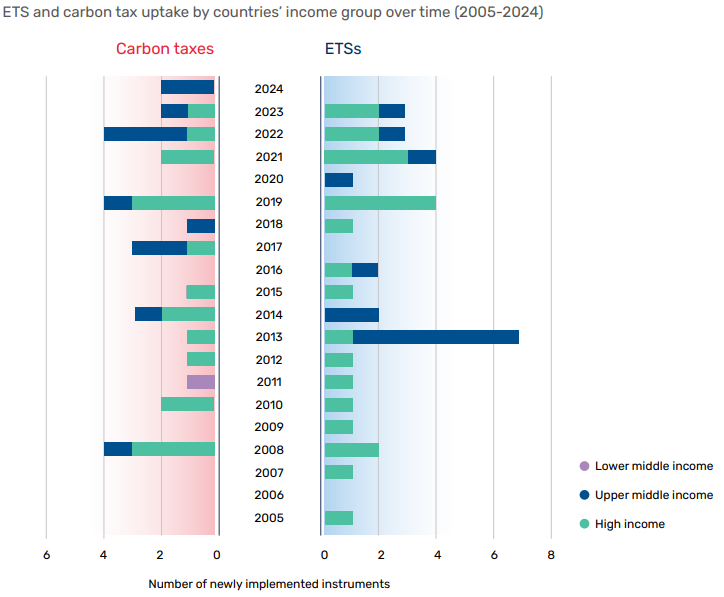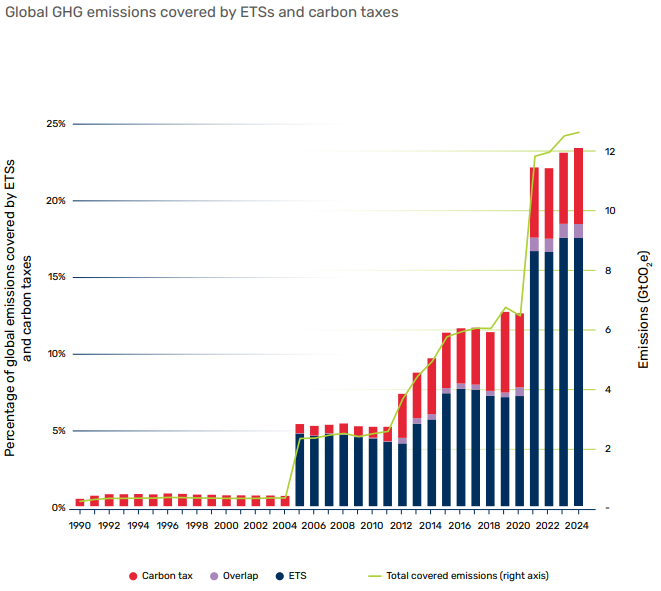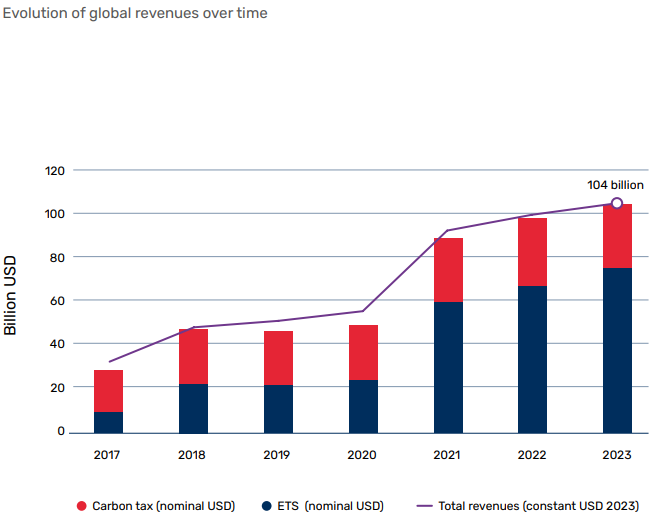Status and Development of Carbon Pricing Worldwide in 2024

Carbon pricing is becoming an increasingly powerful tool in the fight against climate change. Assigning a cost to greenhouse gas emissions, incentivizes businesses and individuals to reduce their carbon footprint. Additionally, with the introduction of the European Union’s Carbon Border Adjustment Mechanism (CBAM), carbon pricing becomes even more relevant for companies.
CBAM imposes a carbon price on imports into the EU, leveling the playing field between EU producers subject to the EU Emissions Trading System (ETS) and foreign producers. Notably, carbon prices paid in third countries by the producers will be deducted from the CBAM liability, influencing import costs for CBAM goods. This can also encouraging countries outside of the EU to adopt carbon pricing measures to collect the carbon taxes themself.

Overview of Carbon Pricing
Carbon pricing can take various forms, the most common being carbon taxes and emissions trading systems (ETS).
- Carbon Taxes: These directly set a price on carbon by defining a tax rate on greenhouse gas emissions or the carbon content of fossil fuels. For example, Sweden has one of the highest carbon taxes globally, reaching up to USD 137 per ton of CO2.
- Emissions Trading Systems (ETS): An ETS sets a cap on the total level of greenhouse gas emissions and allows industries with low emissions to sell their extra allowances to larger emitters. The EU ETS is one of the most prominent examples, where prices have exceeded USD 60 per ton of CO2, driving significant emission reductions.
Currently, around 24% of global emissions are covered by these carbon pricing mechanisms, marking significant progress over the past decade.
Global Trends in Carbon Pricing
Over the past ten years, carbon pricing has grown substantially, expanding from covering just 7% of global emissions to nearly a quarter today. This growth reflects the increasing recognition of it as an effective tool for reducing emissions. In the past year, there have been key developments, including the introduction of new carbon pricing instruments in countries like Australia, Hungary, and Mexico, as well as significant reforms in existing systems.

High and Low Carbon Prices
The price of carbon varies significantly across different regions. The European Union’s ETS, Switzerland, and Canada are among the regions with the highest carbon prices. In these areas, the carbon price has reached levels that provide strong incentives for reducing emissions. For instance, the EU ETS has seen prices well above USD 60 per ton of CO2, reflecting stringent policies and high ambition levels.
On the other end of the spectrum, some regions have lower carbon prices. These include countries that are still in the early stages of implementing carbon pricing or those with less ambitious targets. For example, Indonesia and Ukraine have relatively lower carbon prices but are planning to increase them in the coming years to align with global targets and the Paris Agreement.
Revenue from Carbon Pricing
In 2023, global revenue from carbon pricing instruments exceeded USD 100 billion for the first time. This revenue is important for funding climate-related programs, supporting general budgets, and redistributing to households and businesses affected. The majority of this revenue comes from ETSs, primarily due to the large volume of emissions they cover and the relatively high price levels in systems like the EU ETS.

Sectoral Coverage and Flexibility
Carbon pricing is most commonly applied in the power and industrial sectors, but there is a growing trend of extending these mechanisms to other sectors, such as maritime transport and waste management. Additionally, governments are increasingly using multiple carbon pricing instruments in parallel to expand coverage and increase price levels. For example, some jurisdictions have both an ETS and a carbon tax, targeting different sectors or complementing each other to enhance overall effectiveness.
This flexibility allows for more comprehensive and ambitious carbon pricing strategies, tailored to the specific economic and social contexts of different regions. The increasing use of carbon credits to offset liabilities also provides flexibility, enabling entities to meet their obligations in a cost-effective manner while supporting global emission reduction efforts.
Challenges and Future Outlook
Despite significant progress, there remains a substantial gap between commitments and actual implemented policies. Achieving the Paris Agreement’s goals will require stronger political commitment and broader implementation of carbon pricing. This includes expanding coverage to new sectors and increasing carbon prices to levels that drive substantial emission reductions.
The future of carbon pricing looks promising, with middle-income countries like Brazil, India, and Türkiye making notable progress towards implementing carbon pricing instruments. Additionally, sector-specific initiatives, such as those for international aviation and shipping, are gaining traction and contributing to the overall expansion of these climate-related financial mechanisms.
Conclusion
Carbon pricing has made significant progresses over the past decade, but more ambitious and comprehensive policies are needed to meet global climate targets. By understanding the current state and trends of carbon pricing worldwide, stakeholders can better support and advocate for policies that drive effective emission reductions. Staying informed and engaged in these developments is crucial for ensuring a sustainable and livable planet for future generations.



